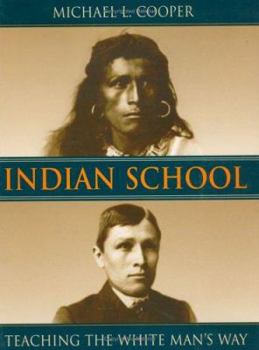Indian School: Teaching the White Man's Way
In 1879 eighty-four Sioux boys and girls became the inaugural group of students to be enrolled at the Carlisle Indian School in Pennsylvania. Carlisle was the first institution opened by the federal... This description may be from another edition of this product.
Format:Hardcover
Language:English
ISBN:0395920841
ISBN13:9780395920848
Release Date:January 1999
Publisher:Clarion Books
Length:112 Pages
Weight:1.05 lbs.
Dimensions:0.6" x 7.3" x 9.3"
Age Range:10 to 12 years
Grade Range:Grades 5 to 7
Related Subjects
9 - 12 Years Biographies Children's Children's Books Education & Reference MulticulturalCustomer Reviews
4 ratings
Review of Indian School
Published by Thriftbooks.com User , 24 years ago
This absorbing book addresses the issue of cultural imperialism in thoughtful ways. It explores how federally funded schools sought to teach "the white man's ways" to Native American children in the late-nineteenth and early-twentieth century. Balanced and sensitive to the past, Cooper acknowledges that the founder and teachers generally had good intentions and opened opportunities for some students. There is even a delightful chapter on "Pop" Warner's successful program in Carlisle PA. Yet, without resorting to heavy-handed editorializing, the author uses the evidence to establish that the inability to accept cultural differences harmed the youths. Cooper does an outsatnding job telling the story from the students' point of view. The photographes of dailylife at the schools are wonderful. Rich in personal details, Indian School will engage young readers.
Review of Indian School
Published by Thriftbooks.com User , 24 years ago
This absorbing book addresses the issue of cultural imperialism in thoughtful ways. It explores how federally-funded schools sought to teach "the white man's ways" to Native Americans children in the late-nineteeenth and early twentieth century. Balanced and sensitive to the past, Cooper acknowledges that the teachers generally had good intentions and opened opportunities for some students. Thre is even a delightful chapter on "Pop" Warner's successful football program a the school in Carlisle PA. Yet, without resorting to heavy-handed editorializing, the author uses the evidence to establish that the inability to accept cultural differences harmed the youths. Cooper does an outstanding job telling the story from the students' point of view. The photographs of daily life at the school are wonderful. Rich in personal details, Indian School will engage young readers.
School of Tears
Published by Thriftbooks.com User , 25 years ago
The story of the US Government's misguided effort to assimilate native amercian children into the white man's world. Cooper gives us a clear account of the personal tragedies suffered by the children. The concise narrative is easy to understand and should help todays children understand the injustices that were inflicted on their peers over a hundred years ago. The unbiased telling of this tragedy from american history is much more than bland history, it is the story of American do-gooderism gone amuck. The stories of children who willed themselves to die rather than remain in the Indian Schools separated from family and friends and from their centuries old cultures and heritage. This book is very informative and should motivate readers to find out more about the subject.
Teaching the "white man's way" to Indian children
Published by Thriftbooks.com User , 25 years ago
I thoroughly enjoyed reading Indian School. The book describes the attempt, in the 1880's, to educate Native American children in established Eastern boarding schools. The author provides an unbiased description of the motives of those who established this program. But I think the best parts of the book are the descriptions, from the Indian children's perspective, of the traumatic change that was forced on them. These children were removed from their families and culture and shipped off to Carlisle, PA to learn the "white man's ways". Indian School includes many first hand accounts from these children. This use of the children's own words works well to allow the reader to understand the confusion, resentment, excitement, and awe that these Native American students felt as they were forced into a completely foreign, and sometimes hostile environment. The book also includes wonderful examples of how these children assimilated while stubbornly continuing to express their heritage. After reading this book, I want to learn more about these people.





